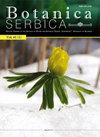Phenolic profile and biological potential of wild blackberry (Rubus discolor) fruits
IF 1.1
4区 生物学
Q4 PLANT SCIENCES
引用次数: 1
Abstract
The berries of Rubus discolor are considered a rich source of phytochemicals which could play an important role in the prevention of prevalent contemporary chronic diseases. Thus, the goal of the presented study was to determine the profile of phenolic acids and anthocyanins of aqueous and ethanol extracts of R. discolor fruit, and their free radical scavenging, antiproliferative, antidiabetic and antimicrobial activities. LC-MS/MS analyses confirmed the presence of 11 phenolic acids with protocatechuic and gallic acids being the major compounds. Additionally, cyanidin- glucoside/galactoside was the most abundant among the five identified anthocyanins. The ethanol extract was more efficient in scavenging free radicals than the aqueous extract. The absence of antiproliferative activity was observed for both extracts. However, they inhibited carbohydrate hydrolysing digestive enzymes associated with type-2 diabetes. Furthermore, the obtained results for ?-glucosidase inhibitory activity (IC50 values 44.52 and 80.72 ?g/mL, for the aqueous and ethanol extracts, respectively) indicate significantly higher activity than the positive control, GlucobayR (233.38 ?g/mL). The ethanol extract was more effective against all of the examined bacteria (Bacillus cereus, Staphylococcus aureus and Enterobacter cloacae) than the aqueous extract. On the contrary, the aqueous extract showed better antifungal properties, particularly against Trihoderma viride and Penicillium verrucosum var. cyclopium. The quantified phenolics and presented bioactivities of R. discolor fruit extracts candidate them as a potential source of bioactive compounds which might be used in the food, pharmacy and cosmetic industries.野生黑莓果实的酚类特征及其生物学潜力
红莓被认为是植物化学物质的丰富来源,可以在预防流行的当代慢性疾病中发挥重要作用。因此,本研究的目的是确定黄芩水提物和乙醇提物中酚酸和花青素的含量,以及它们的自由基清除、抗增殖、抗糖尿病和抗菌活性。LC-MS/MS分析证实了11种酚酸的存在,其中原儿茶酸和没食子酸是主要化合物。其中花青素-葡萄糖苷/半乳糖苷含量最高。乙醇提取物清除自由基的效率高于水提取物。两种提取物均无抗增殖活性。然而,它们抑制了与2型糖尿病相关的碳水化合物水解消化酶。此外,水提物和乙醇提物的-葡萄糖苷酶抑制活性(IC50值分别为44.52和80.72 μ g/mL)显著高于阳性对照GlucobayR (233.38 μ g/mL)。乙醇提取物对所有检测的细菌(蜡样芽孢杆菌、金黄色葡萄球菌和阴沟肠杆菌)比水提取物更有效。相反,水提物具有较好的抗真菌性能,特别是对绿色木霉和疣状青霉。结果表明,该果实提取物的酚类物质含量和生物活性是一种潜在的生物活性物质来源,可用于食品、制药和化妆品等行业。
本文章由计算机程序翻译,如有差异,请以英文原文为准。
求助全文
约1分钟内获得全文
求助全文
来源期刊

Botanica Serbica
Agricultural and Biological Sciences-Plant Science
CiteScore
1.40
自引率
12.50%
发文量
17
审稿时长
34 weeks
期刊介绍:
Botanica Serbica publishes original research papers on all aspects of plant, fungal and microbial biology research including the disciplines of microbiology, mycology, lichenology, bryology, flora, vegetation, biogeography, systematics, taxonomy, plant biotechnology, plant cell biology, plant ecology, environmental plant biology, forestry, genomics, horticulture, limnology, metabolomics, molecular biology, proteomics, virology, plant conservation and protection, and wildlife and ecosystem management.
 求助内容:
求助内容: 应助结果提醒方式:
应助结果提醒方式:


